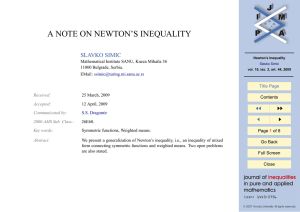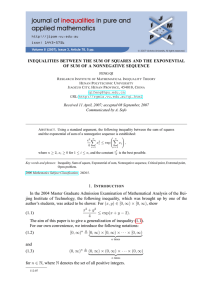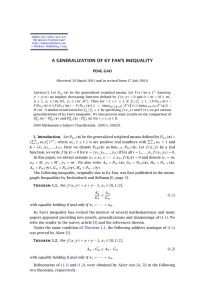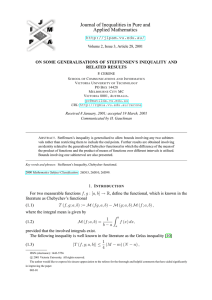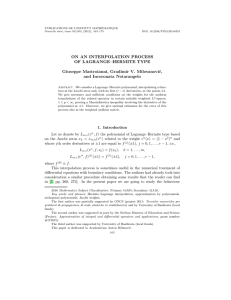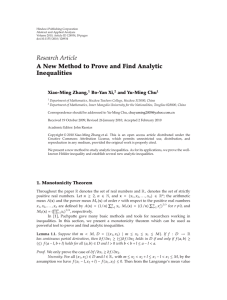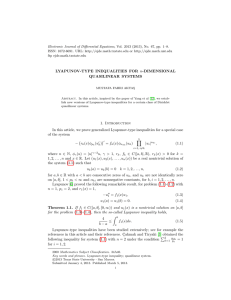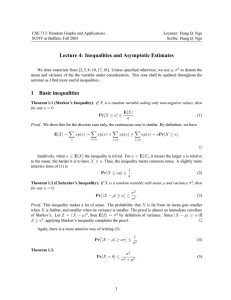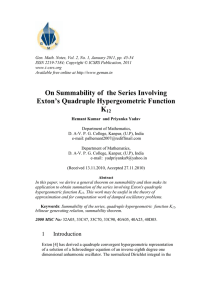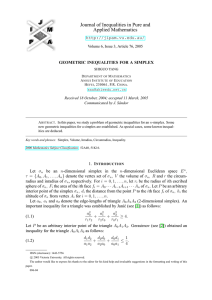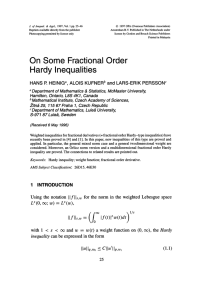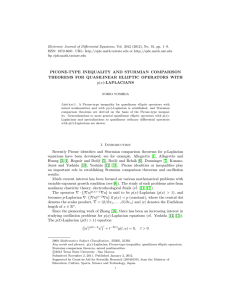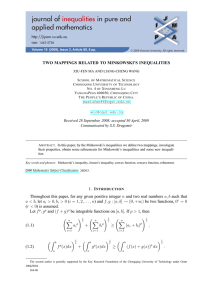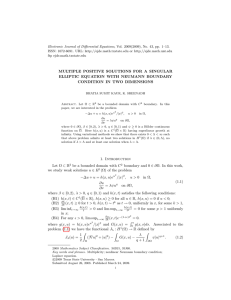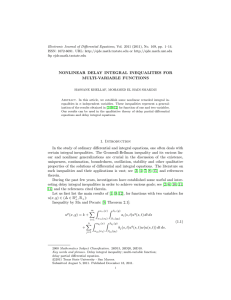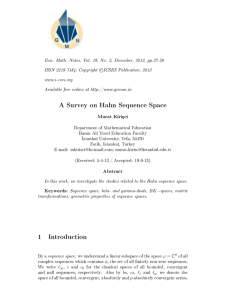A NOTE ON NEWTON’S INEQUALITY Communicated by S.S. Dragomir
advertisement
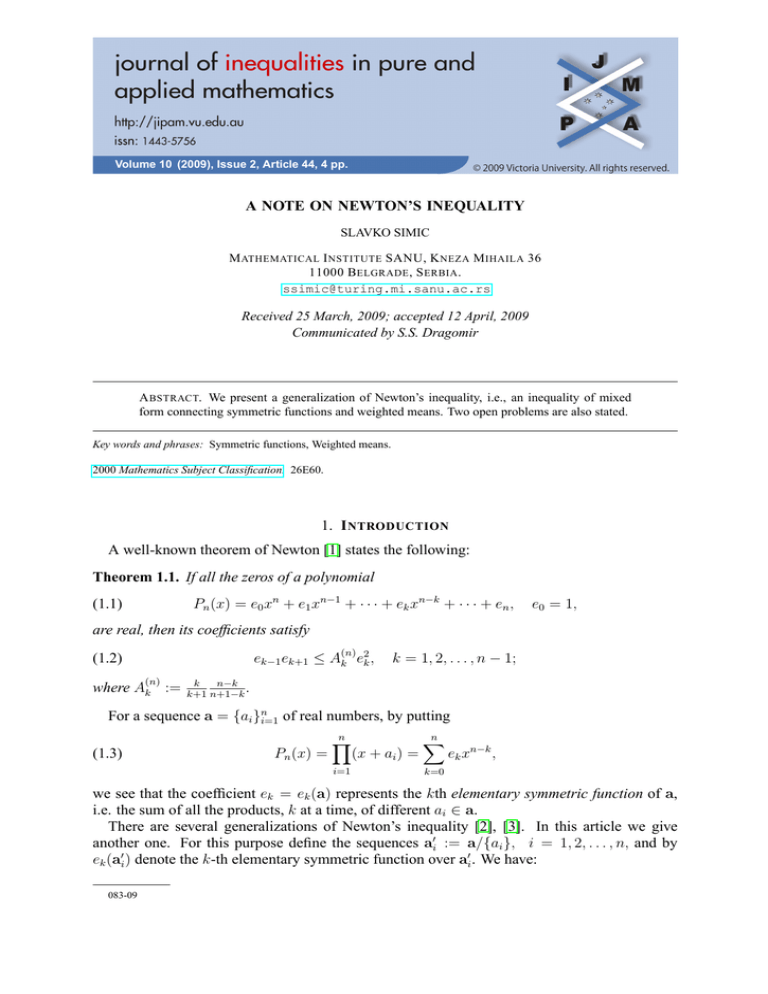
Volume 10 (2009), Issue 2, Article 44, 4 pp.
A NOTE ON NEWTON’S INEQUALITY
SLAVKO SIMIC
M ATHEMATICAL I NSTITUTE SANU, K NEZA M IHAILA 36
11000 B ELGRADE , S ERBIA .
ssimic@turing.mi.sanu.ac.rs
Received 25 March, 2009; accepted 12 April, 2009
Communicated by S.S. Dragomir
A BSTRACT. We present a generalization of Newton’s inequality, i.e., an inequality of mixed
form connecting symmetric functions and weighted means. Two open problems are also stated.
Key words and phrases: Symmetric functions, Weighted means.
2000 Mathematics Subject Classification. 26E60.
1. I NTRODUCTION
A well-known theorem of Newton [1] states the following:
Theorem 1.1. If all the zeros of a polynomial
Pn (x) = e0 xn + e1 xn−1 + · · · + ek xn−k + · · · + en ,
(1.1)
e0 = 1,
are real, then its coefficients satisfy
(n)
ek−1 ek+1 ≤ Ak e2k ,
(1.2)
(n)
where Ak :=
k = 1, 2, . . . , n − 1;
k
n−k
.
k+1 n+1−k
For a sequence a = {ai }ni=1 of real numbers, by putting
(1.3)
n
n
Y
X
Pn (x) =
(x + ai ) =
ek xn−k ,
i=1
k=0
we see that the coefficient ek = ek (a) represents the kth elementary symmetric function of a,
i.e. the sum of all the products, k at a time, of different ai ∈ a.
There are several generalizations of Newton’s inequality [2], [3]. In this article we give
another one. For this purpose define the sequences a0i := a/{ai }, i = 1, 2, . . . , n, and by
ek (a0i ) denote the k-th elementary symmetric function over a0i . We have:
083-09
2
S LAVKO S IMIC
Theorem 1.2. Let c = {ci }ni=1 be a weight sequence of non-negative numbers satisfying
n
X
(1.4)
ci = 1,
i=1
and, for an arbitrary sequence a = {ai }ni=1 of real numbers, define
(c)
Ek
(1.5)
:=
n
X
(c)
ci ek (a0i ),
E0 = 1,
i=1
or equivalently,
(1.6)
(c)
Ek = ek − ek−1 f1 + ek−2 f22 − · · · + (−1)r ek−r frr + · · · + (−1)k fkk ,
where
n
X
fs :=
(1.7)
! 1s
ci asi
.
i=1
Then
(1.8)
(c)
(c)
(n−1)
Ek−1 Ek+1 ≤ Ak
(c)
Ek
2
k = 1, 2, . . . , n − 1.
,
Proof. We shall give an easy proof supposing that the sequence c consists of arbitrary positive
rational numbers. Since a and c are independent of each other, the truthfulness of the above
theorem follows by the continuity principle.
Therefore, let p = {pk }nk=1 be an arbitrary sequence of positive integers and put
pi
(1.9)
ci = Pn , i = 1, 2, . . . , n; p ∈ N.
1 pk
Now, for a given real sequence a, consider the polynomial Q(x) defined by
(1.10)
n
Y
Q(x) :=
(x + ai )pi .
i=1
Since all its zeros are real, by the well-known Gauss theorem, the zeros of Q0 (x),
(1.11)
0
Q (x) = Q(x)
n
X
i=1
pi
,
x + ai
are also real.
In particular, the same is valid for the polynomial R(x) defined by
(1.12)
n
n
Y
X
R(x) :=
(x + ai )
i=1
i=1
ci
.
(x + ai )
Since
(1.13)
(c)
(c)
(c)
R(x) = xn−1 + E1 xn−2 + · · · + Ek xn−1−k + · · · + En−1 ,
the result follows by simple application of Theorem 1.1.
P
Remark 1. Since ni=1 ek (a0i ) = (n − k)ek (a), putting ci = 1/n, i = 1, 2, . . . , n in (1.5) and
(1.8), we obtain the assertion from Theorem 1.1. Hence our result represents a generalization
of Newton’s theorem.
J. Inequal. Pure and Appl. Math., 10(2) (2009), Art. 44, 4 pp.
http://jipam.vu.edu.au/
N EWTON ’ S I NEQUALITY
3
P
(c)
1/s
Also, denoting by fs (a) = fs := ( ni=1 ci asi ) , s > 0, the classical weighted mean (with
weights c) of order s, and using the identity
ek (a0i ) = ek (a) − ai ek−1 (a0i ),
(1.14)
(c)
an equivalent form of Ek arises, i.e.,
(c)
Ek = ek − ek−1 f1 + ek−2 f22 − · · · + (−1)r ek−r frr + · · · + (−1)k fkk .
(1.15)
Putting this in (1.8), we obtain a mixed inequality connecting elementary symmetric functions with weighted means of integer order.
Problem 1.1. An interesting fact is that non-negativity of c is not a necessary condition for
(1.8) to hold. We shall illustrate this point by an example. For k = 1, n = 3, we have
(c)
(c)
(c)
(E1 )2 − 4E0 E2
= (c1 (a2 + a3 ) + c2 (a1 + a3 ) + c3 (a1 + a2 ))2 − 4(c1 a2 a3 + c2 a1 a3 + c3 a1 a2 )
= (1 − c2 )2 (a1 − a2 )2 + 2(c1 − c2 c3 )(a1 − a2 )(a3 − a1 ) + (1 − c3 )2 (a3 − a1 )2 ,
and this quadratic form is positive semi-definite whenever c1 c2 c3 ≥ 0.
Hence, in this case the inequality (1.8) is valid for all real sequences a with c satisfying
(1.16)
c1 + c2 + c3 = 1,
c1 c2 c3 ≥ 0.
Therefore there remains the seemingly difficult problem of finding true bounds for the sequence c satisfying (1.4), such that the inequality (1.8) holds for an arbitrary real sequence
a.
Problem 1.2. There is an interesting application of Theorem 1.2 to the well known Turan’s
problem. Under what conditions does the sequence of polynomials {Qn (x)} satisfy Turan’s
inequality
(1.17)
Qn−1 (x)Qn+1 (x) ≤ (Qn (x))2 ,
for each x ∈ [a, b] and n ∈ [n1 , n2 ]?
This problem is solved for many classes of polynomials [4]. We shall consider here the
following question [5].
An arbitrary sequence {di }, i = 1, 2, . . . of real numbers generates a sequence of polynomials
{Pn (x)}, n = 0, 1, 2, . . . defined by
(1.18)
Pn (x) := xn + d1 xn−1 + d2 xn−2 + · · · + dn−1 x + dn ,
P0 (x) := 1.
Denote also by An the set of zeros of Pn (x).
Now, if for some m > 1 the set Am consists of real numbers only, then from Theorem 1.2, it
follows that
(1.19)
Pn−1 (a)Pn+1 (a) ≤ Pn2 (a),
for each a ∈ Am and n ∈ [1, m − 1].
Is it possible to establish some simple conditions such that the Turan inequality
(1.20)
Pn−1 (x)Pn+1 (x) ≤ Pn2 (x),
holds for each x ∈ [min a, max a]a∈Am and n ∈ [1, m − 1].
J. Inequal. Pure and Appl. Math., 10(2) (2009), Art. 44, 4 pp.
http://jipam.vu.edu.au/
4
S LAVKO S IMIC
R EFERENCES
[1] G.H. HARDY, J.E. LITTLEWOOD
1978.
AND
G. POLYA, Inequalities, Camb. Univ. Press, Cambridge,
[2] J.N. WHITELEY, A generalization of a theorem of Newton, Proc. Amer. Math. Soc., 13 (1962),
144–151.
[3] K.V. MENON, Inequalities for symmetric functions, Duke Math. J., 35 (1968), 37–45.
[4] S. SIMIC, Turan’s inequality for Appell polynomials, J. Ineq. Appl., 1 (2006), 1–7.
[5] S. SIMIC, A log-concave sequence, Siam Problems and Solutions, [ONLINE: http//:www.
siam.org].
J. Inequal. Pure and Appl. Math., 10(2) (2009), Art. 44, 4 pp.
http://jipam.vu.edu.au/
